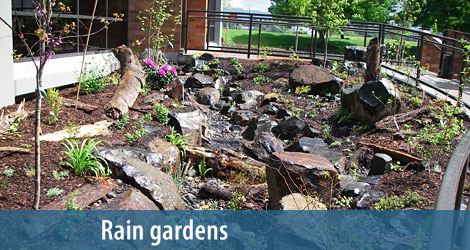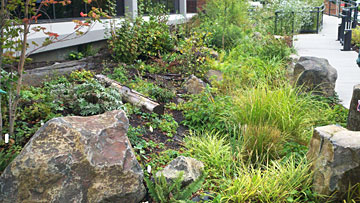Rain gardens
Rain gardens act much like bioretention facilities, but are typically smaller and not engineered. Often, they are shallow depressions in a small catchment area that naturally allows water to infiltrate the soil. Some rain gardens disperse runoff from down spouts or other collection features, such as curbs. Rain gardens are planted with diverse native plants that can handle the rainy season, temporary flooding and dry conditions. These features are located on small sites such as homes or small commercial areas with limited impervious surfacing.
FEATURED SITES - Clark Public Utilities Operations Center
8600 NE 117th Ave., Vancouver
The rain garden at Clark Public Utilities was designed to manage stormwater and function as a demonstration project to treat and retain roof runoff. The retrofit is part of the facility’s LEED certification program.
Rain garden – The facility collects runoff from the roof of the operations center’s addition. It is designed to resemble a stream, and contains three overflowing pools and an overflow catch basin at the low point of the third pool. The pools have 12-18 inches of well-draining soil amendments over a perforated pipe underdrain. The overflow catch basin and underdrain are connected to the site’s infiltration system. The rain garden features locally quarried basalt boulders at the edge of the stream and an outcropping at the adjacent planting beds. Some of the stones function as waterfall rocks for weirs between pools and seating rocks. The garden also features a significant amount of large woody material. Some of it functions as log edges for the stream, and some is buried vertically to resemble stumps. Some functions as woody debris in the planting beds and stream, and some was buried under the pools and planting beds. The rain garden features a variety of native, non-native, edible, wetland and upland plants.
Washougal downtown improvements
E Street between 3rd & 32nd streets; Pendelton Way between C & Main streets; Main Street between Pendelton Way & 19th Street, Washougal
Washougal retrofitted several downtown streets to include rain gardens to capture water from roadways and adjacent right-of-way areas. They vary in design, function and shape based on specific site conditions. All gardens include a variety of materials, including native plantings, mulch layers, gravel, tree plantings and overflow devices. Permeable pavers are also used in parking areas.
[video:https://youtu.be/PExoXmi0tHs width:560 height:315 align:center]
Seen how rain gardens and pervious pavements work in downtown Washougal.
LID Techniques

